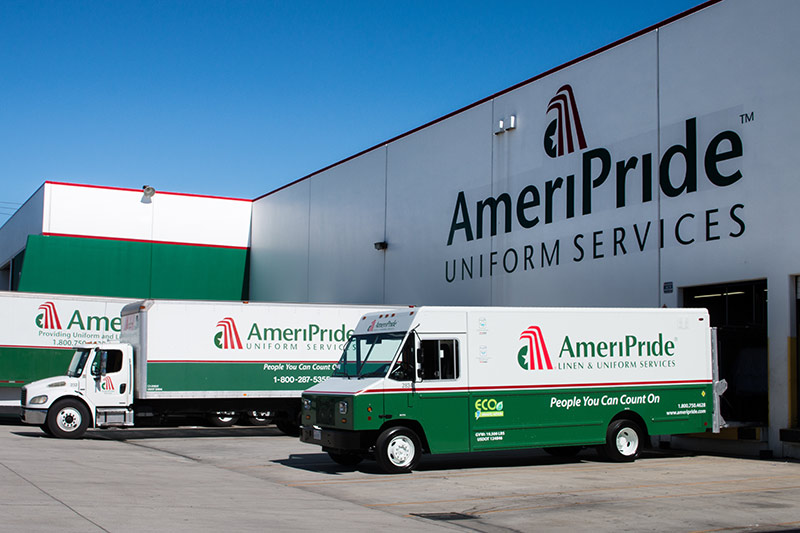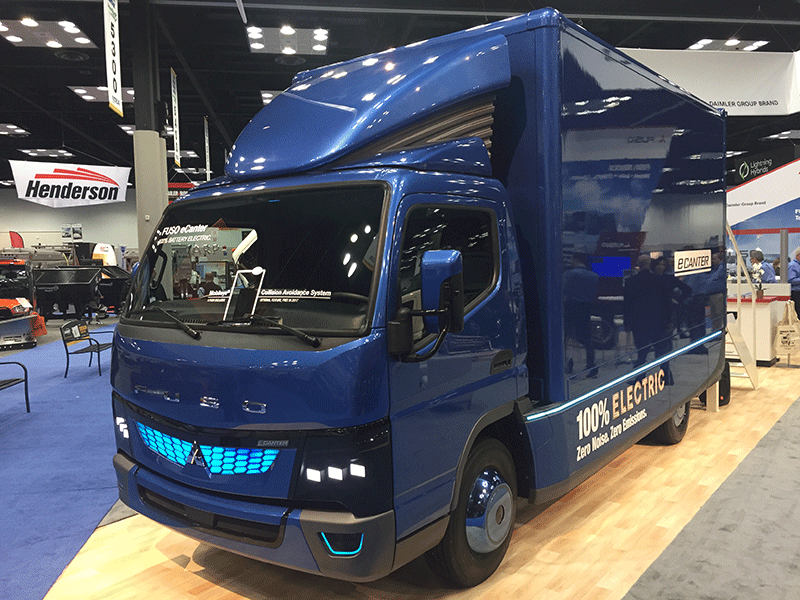Alternative fuel vehicles – electric delivery trucks, vehicles powered by liquid propane and a hybrid pickup – were front and center at the 2017 Work Truck Show in Indianapolis this week. The only thing missing was interested buyers.
At a time when the price of gasoline and diesel fuel is in the low- to mid-$2 range, there’s little incentive for truck operators to transition to expensive alternative fuel powertrains. Meanwhile, with the Trump administration signaling a broad walk back from federal environmental regulation – planning to cut the budget of the Environmental Protection Agency by nearly a third – there is diminishing pressure on fleets to invest in new technology.
“We don’t get many calls from our customers any more asking for propane or natural gas trucks,” said Roy Hiatt, fleet sales manager for Isuzu Commercial Truck of America.
Hiatt blamed the lack of interest on low gasoline and diesel prices.
Isuzu will launch production of an all-new four-cylinder engine turbodiesel medium-duty truck in Charlotte, Mich., starting in May.
Liquid propane – an alternative fuel that gained popularity during the last period of high gasoline prices – has seen a fall-off.
“Orders for new propane trucks are slowing down among new fleet buyers of trucks,” said Jim Bunsey, director of operations for Superior Energy, which makes liquid propane, or autogas, fueling dispensers.
Dealers and fleet operators at the show said interest in alternative fuel trucks rose from 2011 through 2013, when fuel prices approached $4 a gallon nationally, but has slacked off since. But there is little customer interest now because they cost more to purchase and it takes too long to make up the difference.
Still, there are some companies and fleets pushing ahead into less-polluting, alternative fuel technology.
Motiv Power Systems, a Foster City, Calif., company that uses a Ford truck chassis to build electric delivery trucks and school buses, said it is seeing continued demand for alternative fuel vehicles.
Moves by the federal government to loosen environmental regulations “won’t matter a lot because all the sales incentives we get for our vehicles are state based,” said Shyam Nagrani, Motiv’s vice president of business development.
California, with its strict environmental regulations, has lead the way, with New York and the seven-county Chicago metropolitan now offering similar incentives to induce purchases of green trucks, Nagrani said.
All these programs are funded locally and don’t rely on federal dollars. Nagrani said federal green truck grants, for example, will amount to just one tenth the level of what California offers and are split among all 50 states.
He expects continued interest.
“Everybody wants clean air regardless of what the Trump administration has said,” Nagrani said.
AmeriPride Services, a linen and uniform supply company, will have 30 Motiv trucks in its 2,000-vehicle fleet by the end of next year, said Banny Allison, feet manager of the Minnetonka, Minn., company.

Motiv AmeriPride fleet. (Photo: Motiv)
AmeriPride has a 10-year plan to convert most its large diesel fleet to alternative fuel vehicles but has not settled on a single technology, Allison said.
The biggest hurdle to Motiv sales growth is the $150,000 expense of converting the Ford chassis to an electric drive. But the cost of the battery packs that amount to more than half of that figure are dropping at an annual rate of about 12 percent, Nagrani said.
Nagrani expects that decline to continue or even rise as Tesla Inc. adds capacity to its giant battery factory near Reno, Nev., producing more than the automaker can use for its electric cars.
Mitsubishi Fuso announced at the Work Truck Show that it will bring a new line of electric work trucks to the North American market this year.
The division of German automotive giant Daimler AG said it will launch a lease program for its eCanter electric truck and will follow it up with a second generation model within two years.

Fuso’s eCanter electric delivery truck. (Photo: Jerry Hirsch/Trucks.com)
“We want Fuso to be the Tesla of electric trucks,” said Jecka Glasman, chief executive of Fuso.
Fuso is moving forward with its electric truck strategy both in the U.S. and internationally because it believes increased congestion in city centers and a global movement to reduce greenhouse gas emissions and noise pollution will create demand for the vehicle, Glasman said.
Cities in Europe are considering banning combustible engines by 2030 to combat climate change.
Elsewhere at the show, Roush CleanTech of Livonia, Mich., showcased its delivery trucks retrofitted to run autogas. The trucks are popular with food companies such as Nestle and Bimbo and for buses used by school districts and shuttle companies.
XL Hybrid of Boston, Mass., displayed its hybrid electric drive system for Ford’s range of F-Series trucks and as a plug-in hybrid upgrade for the F-150 pickup.
Workhorse Group of Loveland, Ohio, showed the first three dimensional model of an all-electric pickup truck that it plans to bring to market next year.
Earlier this week, UPS said it would spend $90 million to build an additional six compressed natural gas, or CNG, fueling stations and purchase 390 CNG and 50 liquefied natural gas, or LNG, trucks.

Model of Workhorse Group’s W-15 electric pickup truck. (Photo: Jerry Hirsch/Trucks.com)
Mostly it is the operators of large fleets that still request alternative fuel trucks, said Jim Hawthorne, a branch manager for Bentley Truck Services, a chain of dealerships in the Northeast that sells Isuzu, Fuso and Hino trucks.
They typically go for natural gas or propane powered vehicles and fill the trucks from their own depots, which saves them from paying retail fuel prices, Hawthorne said.
He is selling to buyers such as LKQ Corp., which purchases 1,000 trucks annually to distribute auto parts to body shops and service centers.
LKQ purchases mostly medium-duty gasoline trucks, said Phil Orosco, senior manager for the company’s national fleet operations.
About 15 percent of its vehicles are powered by propane gas. It’s a hedge against higher fuel expenses.
“We don’t think gas prices will stay at $2 a gallon forever,” Orosco said.
The company has looked at electric trucks, “but the length of our routes and the type of cargo we haul make them not very practical,” he said.
Owners of just one truck or small fleets rarely express any interest in alternative fuel trucks, Hawthorne said, and never ask about an electric truck.
But companies that operate fleets or rely on trucking should take a longer view, said Luke Tonachel, director of the Natural Resources Defense Council’s clean vehicles and fuels project.
“Our sustainable transportation future depends on continued investment in efficiency, clean fuels and clean power,” Tonachel said. “That’s the only way to reduce our dependence on oil and cut dangerous pollution from burning fossil fuels. Investing in clean energy innovation also saves consumers money and creates jobs.”
Source: Trucks
